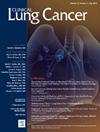Longitudinal Analysis of Recurrence and Risk Factors of Early-Stage Resected Adenocarcinoma With Common EGFR Mutations: A Multicenter Retrospective Cohort Study in South Korea
IF 3.3
3区 医学
Q2 ONCOLOGY
引用次数: 0
Abstract
Introduction
Despite curative surgery for lung cancer, 30% to 55% of patients experience recurrence or death, which highlights the importance of adjuvant treatment. Adjuvant osimertinib therapy effectively prolongs disease-free and overall survival in patients with lung cancer harboring common epidermal growth factor receptor (EGFR) mutations. To identify potential candidates for adjuvant osimertinib, it is crucial to understand the rates and identify risk factors of recurrence.
Methods
This multicenter, retrospective cohort study was conducted in the Republic of Korea and enrolled patients who, between 2010 and 2017, underwent resection of stages I-III adenocarcinomas, with common EGFR mutations. The primary outcomes comprised the rate and risk factors of postoperative recurrence.
Results
Among the 759 participants, the overall recurrence rate and median recurrence-free survival were 39.1% and 59.8 (interquartile range [IQR], 26.3-84.2) months, respectively, during a median follow-up of 73.0 (IQR, 55.4-95.0) months. The recurrence rates for stages IA, IB, IIA, IIB, IIIA, and IIIB were 14.7%, 45.5%, 53.8%, 72.5%, 80.3%, and 93.3%, respectively. Multivariate analysis revealed that age ≥ 65 years, body mass index < 18.5 kg/m², the Del19 subtype of EGFR mutation, tumor size ≥ 2.3 cm, N1 involvement, N2 involvement, predominantly micropapillary or solid pattern, and the presence of visceral pleural invasion were independently associated with recurrence.
Conclusion
This multicenter cohort study demonstrated that stages I-III EGFR-mutated adenocarcinoma has a postoperative recurrence rate of 39.1%, and identified 7 independent risk factors for recurrence.
具有常见EGFR突变的早期切除腺癌复发和危险因素的纵向分析:韩国一项多中心回顾性队列研究
导言:尽管肺癌手术治疗有效,但仍有30% - 55%的患者复发或死亡,这凸显了辅助治疗的重要性。辅助奥希替尼治疗可有效延长携带常见表皮生长因子受体(EGFR)突变的肺癌患者的无病生存期和总生存期。为了确定奥希替尼辅助治疗的潜在候选药物,了解复发率和确定复发危险因素是至关重要的。方法:这项多中心、回顾性队列研究在韩国进行,招募了2010年至2017年期间接受了常见EGFR突变的I-III期腺癌切除术的患者。主要结果包括术后复发率和危险因素。结果:在759名参与者中,总复发率和中位无复发生存期分别为39.1%和59.8(四分位间距[IQR], 26.3-84.2)个月,中位随访时间为73.0个月(IQR, 55.4-95.0)个月。IA期、IB期、IIA期、IIB期、IIIA期、IIIB期复发率分别为14.7%、45.5%、53.8%、72.5%、80.3%、93.3%。多因素分析显示,年龄≥65岁、体重指数< 18.5 kg/m²、EGFR突变Del19亚型、肿瘤大小≥2.3 cm、N1受累、N2受累、以微乳头状或实型为主、内脏性胸膜侵犯的存在与复发独立相关。结论:本多中心队列研究显示,I-III期egfr突变腺癌术后复发率为39.1%,确定了7个独立的复发危险因素。
本文章由计算机程序翻译,如有差异,请以英文原文为准。
求助全文
约1分钟内获得全文
求助全文
来源期刊

Clinical lung cancer
医学-肿瘤学
CiteScore
7.00
自引率
2.80%
发文量
159
审稿时长
24 days
期刊介绍:
Clinical Lung Cancer is a peer-reviewed bimonthly journal that publishes original articles describing various aspects of clinical and translational research of lung cancer. Clinical Lung Cancer is devoted to articles on detection, diagnosis, prevention, and treatment of lung cancer. The main emphasis is on recent scientific developments in all areas related to lung cancer. Specific areas of interest include clinical research and mechanistic approaches; drug sensitivity and resistance; gene and antisense therapy; pathology, markers, and prognostic indicators; chemoprevention strategies; multimodality therapy; and integration of various approaches.
 求助内容:
求助内容: 应助结果提醒方式:
应助结果提醒方式:


